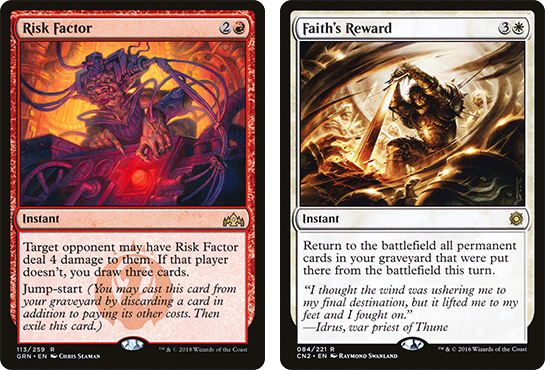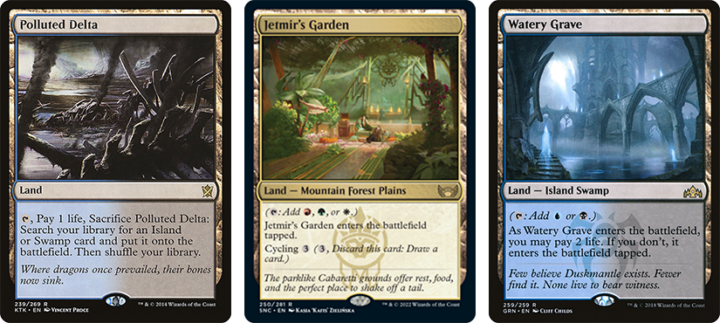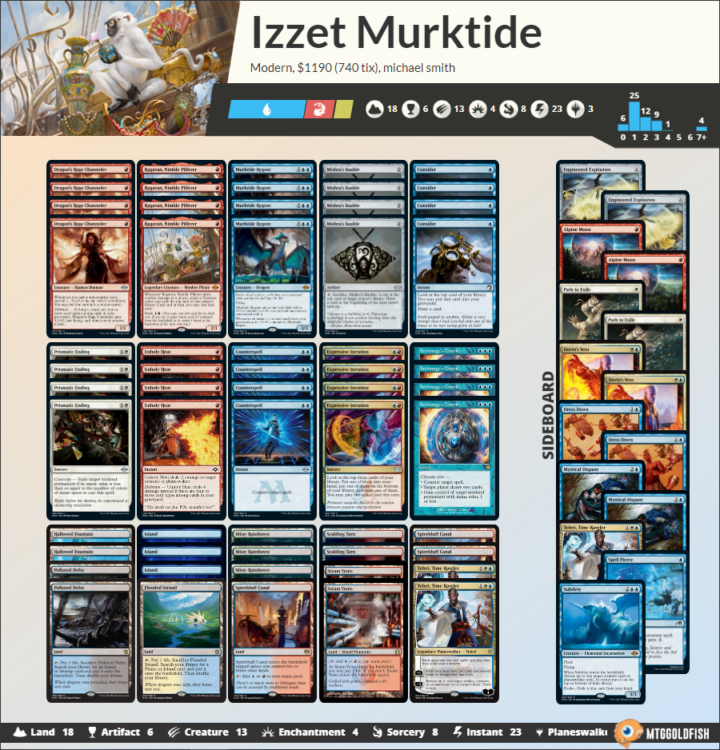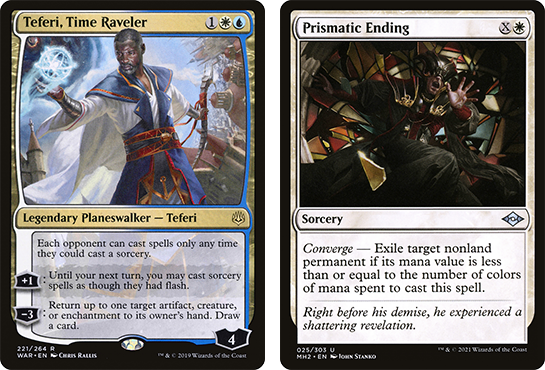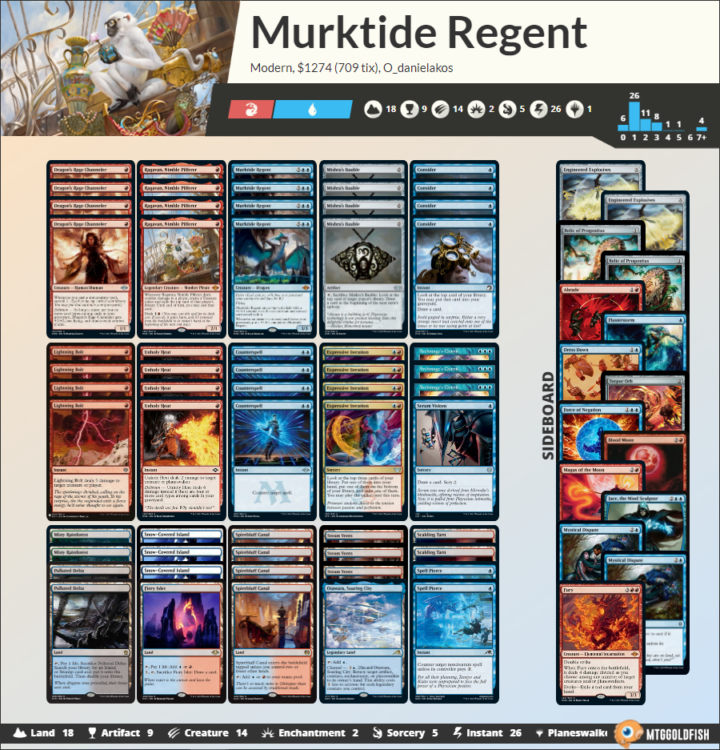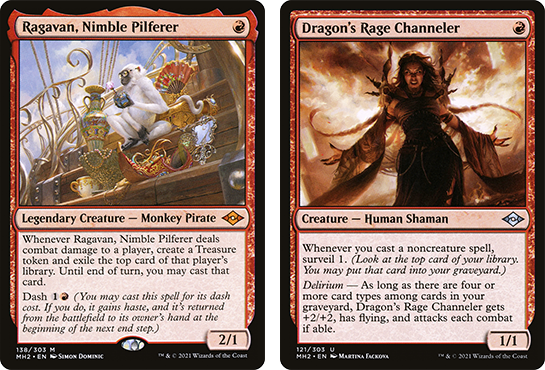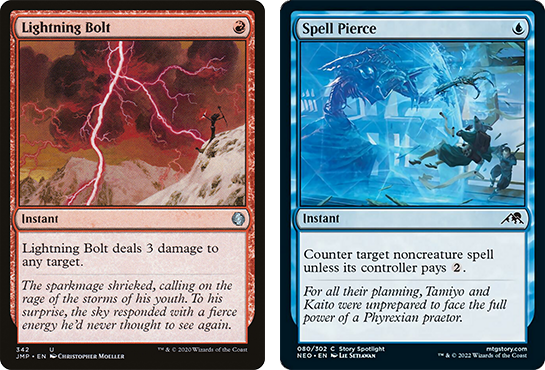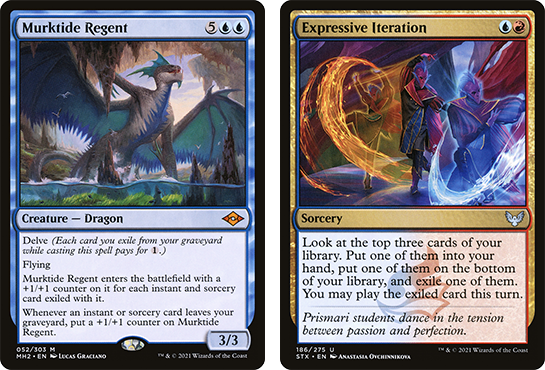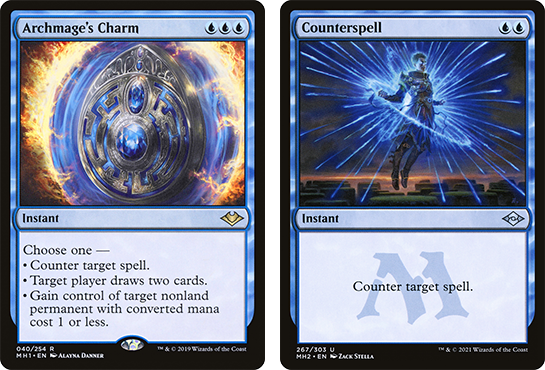There are times where adding that one extra color to a deck seems like the answer to make everything work…but Mason asks, is it?
Foundations
“Things built on a poor foundation will eventually crumble”
– Venetian proverb
Magic is an infinitely deep game. 14,000-plus cards to choose from, all interacting and working together in their own special way. To say building a Magic deck is a daunting challenge is an understatement. Luckily, Magic does a few things to make this process not as daunting as it appears on first blush. You typically are not interested in over 98% of the cards you could play, and very rarely is the whole 14,000 card pool ever applicable. The last big restrictor is mana. Players don’t often think of it, but playable mana is part of what makes this whole process much easier. You don’t have to choose between every card because often you simply can’t cast 3 out of 5 of the colors. We see some players actually struggling to build decks like Four-Color Control in Modern when this soft rule is broken. Today we are going to talk about when it’s worth it to stretch out into more colors, and what you should be looking to do when that happens. Too often players will add a third color without thinking of the risks and rewards.
Now before we go any further, I think it’s important to go over something. Trying to innovate isn’t something that should be shied away from. In writing this article I want to help show players what they should be looking to do when expanding to extra colors to help them innovate better, not stifle their innovation.
In Modern we have the fetch land/shock land mana bases, and most recently have had the Triomes added to that. These allow for any three-color mana base to work at the price of a little extra life. When looking at three-color mana bases you’re expecting your starting life total to be about 15. We have seen decks like Burn take advantage of this fact since Modern’s inception.
At the start of Modern three-color decks were everywhere, in part because you needed the density in colors to have enough powerful spells to keep up with what everyone was doing. Nowadays, thanks to the ramping up of Standard sets and the addition of the Modern Horizons sets into the format, it’s very possible to have a two-color deck with plenty of strong cards and not be behind everyone for doing such.
This opens you up to having stronger, cleaner mana. This is a factor that is often overlooked by Magic players. It’s easy to see why as well. Mana bases are confusing and a medium mana base compared to a great mana base can be hard to spot, especially early on. As such, the benefits of being a two-color deck can sometimes get obfuscated. In Modern it’s very easy to splash a third color and seemingly have it be a minimal impact. Yet the impact is there. For some decks it’s a way larger impact than others. When building your deck you have to decide if stretching to the extra colors is worth giving up that consistency in mana.
At the time of writing this article Izzet Murktide is one of the best decks in Modern. Yet a contingent of people are starting to add more colors to the deck.
Greed
“Greed in the end, fails even the greedy”
– Cathryn Louis
So why do we see Murktide players expanding to a third color? Well, there are many reasons for players, but often it comes from one big factor: wanting an edge in the mirror match. A great example of this is the Jeskai Murktide list.
These lists often play multiple Teferi, Time Raveler, which function as a way to swing the mirror when it comes to slamming Murktides, turning off cards in the opponent’s deck, as well as being a cascade hate card. In fairness at a cursory glance it’s easy to see how people end up in this spot. This is one of the three best decks in Modern right now, and is helpful in the other two matchups to various extents. Besides, are a couple shocks and a couple Teferi’s going to take up too much space and ruin the deck? Once you’re in on White, Prismatic Ending seems like a tempting card as well. After all, it’s one of the best catch-all cards in Modern.
Magic players often hate to feel like they have no agency or control over a situation, so when things like the mirror start popping up they look for an edge. The mirror is seemingly higher variance; after all, you both are playing the same cards so draw steps are what will often decide the match. We will ignore the elephant in the room that player skill will matter as that should go without saying, and simply having me write “get good kid,” while funny, is reductive. Looking for cards that are high impact seems like an easy solution, but what are we giving up in order to make the change from Izzet to Jeskai? Not just in spells, but also in lands. Let’s look at these decks side by side and see what the differences are and see how that impacts our deck.
For starters, your mana is worse at casting Ragavan and Dragon’s Rage Channeler on turn one. In order to make room for the White sources we had to cut a Steam Vents and a Spirebluff Canal. Only one of each, but ultimately Murktide is a deck that historically can function on a single land for a turn or two. Typically your strongest starts are also starting with one of those two cards on the first turn. You have lowered the number of keepable hands by adding the White splash right off the bat.
You’re also trading one Otawara and one Fiery Islet for two fetch lands in order to help make sure you’re able to have the splash color on time. While a seemingly small change it does mean we are losing a land that is powerful in the mirror and against various decks. The theory of having Teferi filling that role is fine, but it does raise the question: If we want Teferi predominantly for the mirror as a way to answer Murktides, should Otawara be one of the cards we are cutting for it?
Another question we should look at when looking at this splash and the cards we have chosen is does our deck have enough lands to make the cards splash work? Both Teferi and Prismatic Ending are mana intensive cards. We are only an 18-land deck just like the normal Murktide decks. It’s possible that we should be looking to play another land to make up for the fact that we are increasing the amount of mana our cards are needing.
It’s worth looking at how the deck structurally looks now as well. To make room for the two Teferi and four Prismatic Endings, we have cut the two Spell Pierce and four Lighting Bolts. For the sake of transparency, the other big change is the Izzet list playing one Serum Visions and the Jeskai list playing a fourth Archmage’s Charm.
Now that we have broken down what the decks look like and how they differ, we can talk about the play patterns. The Izzet deck is able to leave its mana up more often by having a higher number of cheap instant speed spells, and cast multiple spells slightly more often. If you look at how structurally the Murktide deck is laid out, it’s a one-drop-into-Counterspell deck. You’re often trying to get a threat on the board in the first turn or two, then protect it while your opponent spends time answering it. You get slightly further and further ahead and limit the number of turns your opponent has to get out of the pressure you’re putting on them.
So does our splash for White help this goal? Well, not really. Teferi simply doesn’t help this goal. That’s not to say every card should always focus in the same direction, but it’s something that we are expanding into a third color for, and giving up some consistency in the deck for. What about Prismatic Ending? It does answer most things played that can stop our creatures from connecting while being a nice answer to random things from a Sterling Grove to a Chalice of the Void. But it’s a little complicated. Yes it can stop some things, but it also forces you to tap out more. While tapping out isn’t a sin, your deck has a lot of tension when it comes to spending mana on your turn. Also the Prismatic Ending can’t be combined to answer bigger creatures, or do the finishing damage to an opponent – the last of which is the biggest red flag to me. We talked about how our goal is to pressure the opponent and continue to clear the way for our threats. The Lightning Bolts double as both finishing blows and a way to clear most creature based threats in the early game. While not everything is answered by Bolt, it is a large portion of the metagame. Also what about decks where they don’t have good Prismatic Ending targets? Often these decks are playing un-interactive Magic and every single turn counts, so having access to Bolt to shorten the span of the game is vital.
But let’s look even more closely at things with our given premise. We want the White splash for the mirror. So have we achieved this goal? Does giving up consistency and creating these small clashes reach our goal? Because having some nombos in your deck doesn’t mean that you have failed or shouldn’t be doing something like this. These are just things we need to weigh the costs and benefits of. I think the answer is not really. So when looking at the lists head to head you’re actually giving up a lot with these changes with only some being any help at all.
Let’s start with the cutting out the Bolt problem. Like I went over earlier, winning the game is important and Bolt allows you to do that at points where no other card would. You’re also not allowing yourself to play more at instant speed. Consider the following examples. You mulligan and end up keeping two lands, a Lightning Bolt, an Expressive Iteration, Counterspell, and Murktide on the play. You play a land and pass the turn. Your opponent casts a Ragavan and passes back. We Bolt the Ragavan and oh look at us! We drew our own Ragavan, now we can dash our monkey!
But what happens if that same hand has Prismatic Ending? We do nothing on the first turn cycle and while we can still kill the monkey and play out our own, we can never answer an opponent who dashes the monkey with our Ending.
That’s just one of many examples. Magic players love to think about cards only on curve when draws are going well, but those kinds of games almost never really happen. For example: you’re playing the mirror and you have both traded resources for a few turns. You draw a Prismatic Ending. Not the worst; it will answer a Dragon’s Rage Channeler for sure. Your opponent then dashes a Ragavan. That’s one example. What about if you have a Prismatic Ending and an Unholy Heat and your opponent can cast a Murktide for 7 toughness. Your cards don’t really combine to overcome this threat.
I have really hammered this point home because I think Prismatic Ending is simply a card that is not that warping in this shell for the mirror. It’s not like Blue-White or Four-Color Control where the fact it answers non-creatures is more of a draw, and it can fall back on being a creature answer.
So what about Teferi, Time Raveler? Well, it’s complicated. While very strong against Murktide and a great way to turn off all the counter magic your opponent has (which there is a plethora of in both decks), it doesn’t really do all that much to win games that are not about Murktide. Your deck can prevent things like Ragavan from being dashed into it, and you can buy a turn off from a Dragon’s Rage Channeler by Unsummoning it. These are all cheap one-mana cards that you’re trading for a three-mana card. While not as universally panned as I think Prismatic Ending is in the mirror, it’s not a card that fixes or even wins the mirror. With Ending, I spent a lot of time comparing it to Bolt and how they play out. I didn’t do this with Spell Pierce because they fill fundamentally different roles. If you’re curious, I think Spell Pierce being a way to get a threat through Counterspell on an early turn is a way to generate huge advantage and can make cards like Archmage’s Charm incredibly back breaking. For the head-to-head, the Spell Pierce does lose to Teferi if it’s able to get down when you don’t have it, but if you do you’re able to prevent them from quickly slamming the Teferi.
This isn’t to belittle the Jeskai Murktide deck and just point out why Izzet Murktide is better, but it’s to use this as an example and have you think about the questions.
Is the splash I am making worth giving up the consistency in mana I am giving up? Are the spells I am adding helping more match ups then they are hurting? Are the cards I am adding cohesive with my deck as a whole or should I be changing more of the deck to fit these goals?
Knowledge
“Knowledge is useless without consistent application”
– Julian Hall
We spent a lot of words, time, and brain power all to figure out if these White cards are all worth it for the mirror, but ultimately this article was never about figuring out if Jeskai or Izzet Murktide is the truth. We used an example of Murktide because it’s a clear and concise one, but when building your decks going forward, you’re going to have to figure out and apply the concepts talked about today to all your decks and changes you make going forward.
You’re going to mess up and fail, that can not be avoided. But continuously ask these questions and think about what you’re trying to achieve and in time it will become easier to answer the question:
Is the splash worth it?

Mason Clark is a grinder in every corner of the game who has played at the pro level and on the SCG Tour with Team Nova. Whether he’s competing in Standard, Historic or Modern, Mason plays with one goal in mind: to be a better player than he was the day before. Check out his podcast, Constructed Criticism, and catch his streams on Twitch.


